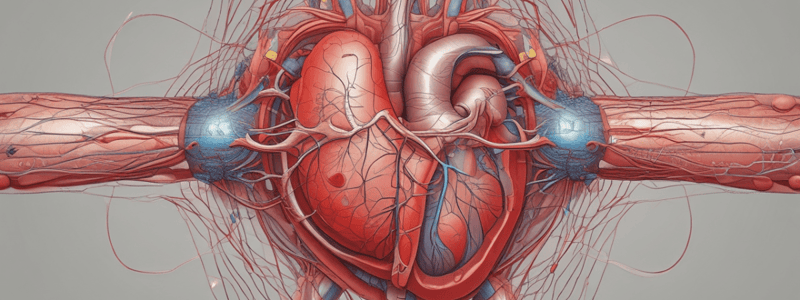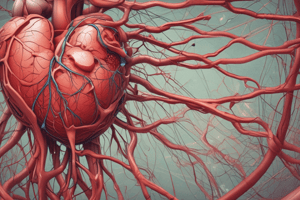Podcast
Questions and Answers
What happens to the elastin content of arterial walls with increasing age?
What happens to the elastin content of arterial walls with increasing age?
- It has no correlation with age, and varies among individuals
- It remains the same, with no significant changes
- It decreases, making the arterial walls less elastic (correct)
- It increases, making the arterial walls more elastic
What is a consequence of the loss of elastin and smooth muscle cells in the arterial walls with increasing age?
What is a consequence of the loss of elastin and smooth muscle cells in the arterial walls with increasing age?
- The arterial walls become more elastic and compliant
- The lumen becomes narrower and shorter
- The valves in the veins become more efficient
- The arterial walls get thicker and stiffer with less nitric oxide available (correct)
What happens to the size of the lumen in the arterial system with increasing age?
What happens to the size of the lumen in the arterial system with increasing age?
- It is variable among individuals, with no correlation to age
- It remains the same, with no significant changes
- It decreases, leading to reduced blood flow
- It increases, leading to increased blood flow (correct)
What is a consequence of the changes in the arterial system with increasing age?
What is a consequence of the changes in the arterial system with increasing age?
What happens to the valves in the veins with increasing age?
What happens to the valves in the veins with increasing age?
What is the analogy used to describe the effect of aging on the arterial walls?
What is the analogy used to describe the effect of aging on the arterial walls?
What is the primary reason for the decreased contractility and elasticity of vascular walls and valves with increasing age?
What is the primary reason for the decreased contractility and elasticity of vascular walls and valves with increasing age?
What is a consequence of the increased thickness of arteries with increasing age?
What is a consequence of the increased thickness of arteries with increasing age?
What is the effect of the loss of smooth muscle cells on the arterial walls?
What is the effect of the loss of smooth muscle cells on the arterial walls?
Why do individuals with age-related changes in the arterial system have a higher risk of hypertension?
Why do individuals with age-related changes in the arterial system have a higher risk of hypertension?
What is the effect of the increased lumen size in the veins with increasing age?
What is the effect of the increased lumen size in the veins with increasing age?
What is the effect of the decreased elastin content on the arterial walls?
What is the effect of the decreased elastin content on the arterial walls?
Study Notes
Aging Changes in the Cardiac Arterial System
- With increasing age, the contractility and elasticity of vascular walls and valves decrease.
- Arterial thickness increases with age, accompanied by an increase in collagen content.
- Elastin content in arterial walls decreases with age, leading to reduced elasticity.
- The lumen of arteries increases in size, and endothelial cells become larger.
- The number of vascular smooth muscle cells decreases, but their size increases.
- The loss of elastin and smooth muscle cells contributes to less elastic and compliant arterial walls.
- This can be likened to a rubber band that gets overstretched, leading to wider and longer lumens and thicker, stiffer arterial walls.
- The availability of nitric oxide, which relaxes smooth muscle cells, decreases with age.
- These changes predispose individuals to atherosclerosis and hypertension, which are not considered normal in the aging process.
Aging Changes in Veins
- The lumen size of veins increases with age.
- Veins become less elastic with age.
- Veins develop less efficient valves, increasing the chance of blood pooling in extremities.
Aging Changes in the Cardiac Arterial System
- With increasing age, the contractility and elasticity of vascular walls and valves decrease.
- Arterial thickness increases with age, accompanied by an increase in collagen content.
- Elastin content in arterial walls decreases with age, leading to reduced elasticity.
- The lumen of arteries increases in size, and endothelial cells become larger.
- The number of vascular smooth muscle cells decreases, but their size increases.
- The loss of elastin and smooth muscle cells contributes to less elastic and compliant arterial walls.
- This can be likened to a rubber band that gets overstretched, leading to wider and longer lumens and thicker, stiffer arterial walls.
- The availability of nitric oxide, which relaxes smooth muscle cells, decreases with age.
- These changes predispose individuals to atherosclerosis and hypertension, which are not considered normal in the aging process.
Aging Changes in Veins
- The lumen size of veins increases with age.
- Veins become less elastic with age.
- Veins develop less efficient valves, increasing the chance of blood pooling in extremities.
Studying That Suits You
Use AI to generate personalized quizzes and flashcards to suit your learning preferences.
Related Documents
Description
This quiz covers the changes that occur in the cardiac arterial systems as we age, including changes in arterial wall structure, contractility, and elasticity. Learn about the effects of aging on the vascular system.




